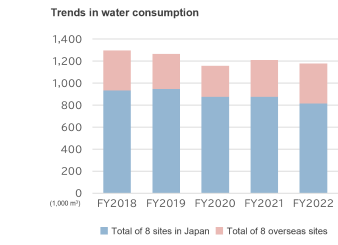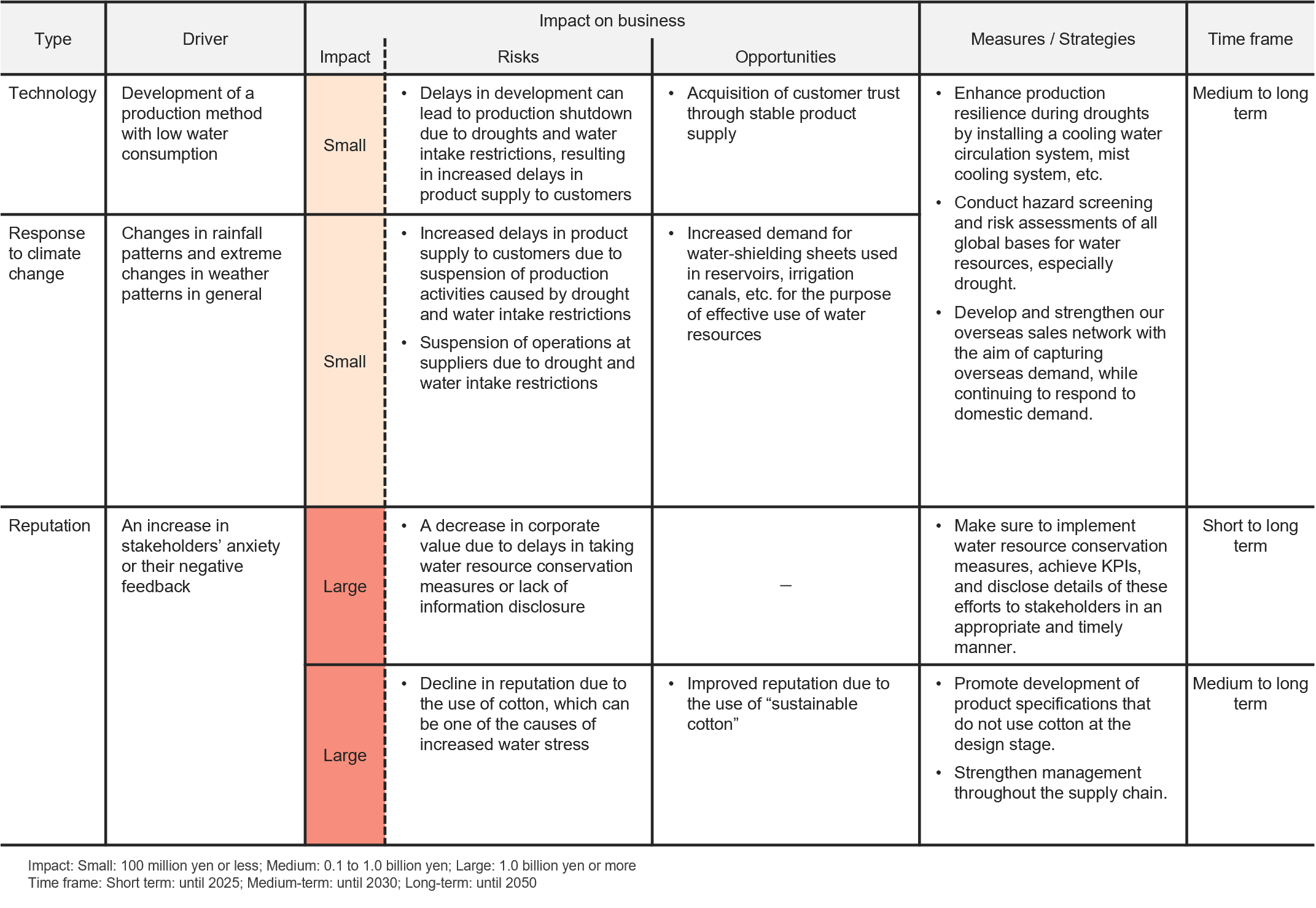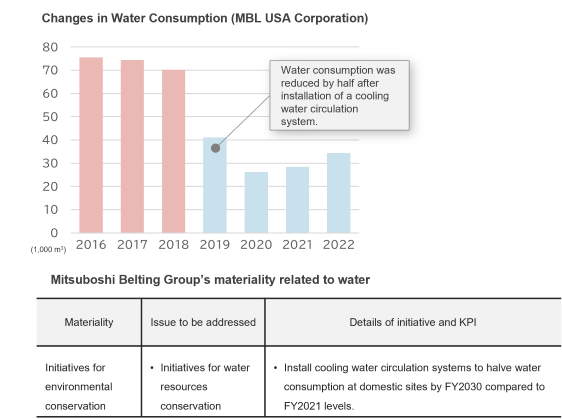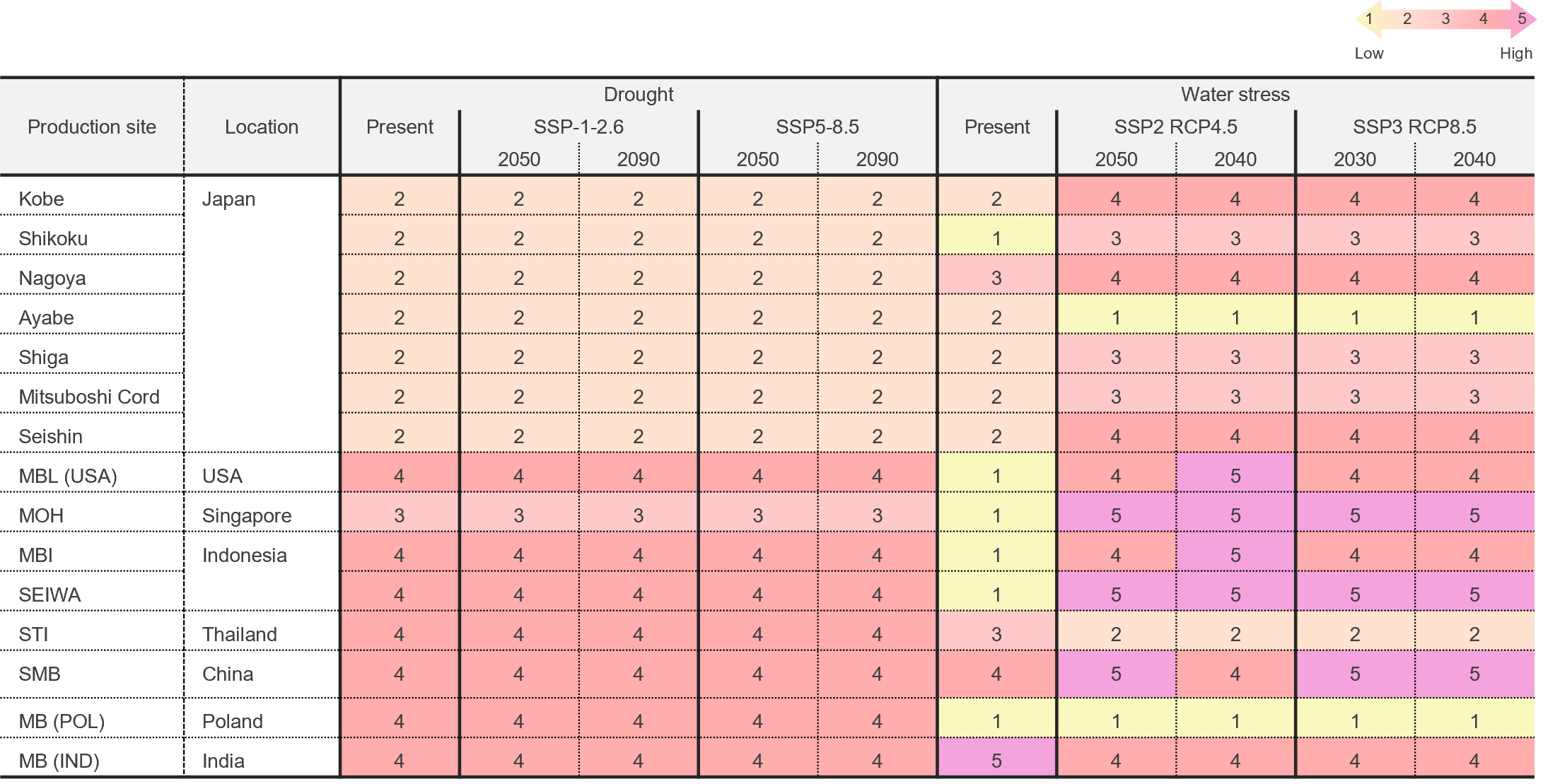Environment
Initiatives to Realize a Resource-Recycling Society
Initiatives to Realize a Resource-Recycling Society
~(1) Water resources~

Recognizing environmental conservation as one of its important management issues, the Mitsuboshi Belting Group has been committed to water resources conservation.
In Japan, where tap water can be used as drinking water and is available at low cost, awareness of water resources conservation tends to fade easily.
In fact, Mitsuboshi Belting Group's production sites in Japan use approximately 2.5 times as much water as its overseas production sites, even though the production volume of transmission belts (main product) at Japanese production sites is only one-third of that of overseas production sites (as of FY2022, see the chart on the right). However, it is by no means of the case that Japan is free from water problems. Droughts occur somewhere in Japan every year.
Meanwhile, looking overseas, the heat wave and drought that hit Europe in 2022 had a major negative impact on agricultural production and also affected electricity supply due to a rise in the temperature of the cooling water at nuclear power plants.
The initiatives for water resources conservation that we are undertaking are closely related to our initiatives to address climate change caused by global warming. Water is an essential resource for our survival. However, contrary to its importance, water is being depleted and polluted, seriously affecting our social lives and economic activities, and the natural environment.
The Mitsuboshi Belting Group is deeply aware of the impact of water depletion and pollution on society, and will strive to conserve water resources in its business activities.
Governance
“Initiatives for water resources conservation” has been taken up as one of the issues to be addressed in the Mitsuboshi Belting Group’s Materiality “initiatives for environmental conservation.” The implementation status of water resource conservation initiatives is monitored and evaluated by the Sustainability Promotion Committee.
・Sustainability management promotion system
・Risk Management
Strategy
We identified risks and opportunities related to water resources conservation and assessed their impact on the Mitsuboshi Belting Group's business activities, along with other business issues, in accordance with the Risk Management Regulations, and based on the assessment results, we developed strategies and targets.
Risk and opportunity identification and impact assessment results

As a result of scenario analysis, we have concluded that "droughts due to climate change" and "increased water stress" caused by changes in the social environment will affect "water withdrawal" in the Mitsuboshi Belting Group's production activities, leading to "increased delays in product supply" if no measures are taken, and to "acquisition of customer trust through stable product supply" if appropriate measures are taken. Furthermore, the use of cotton produced in high water-stressed regions as a raw material poses a risk that could lead to boycotts, as does cotton produced through forced labor. Meanwhile, it is expected that more dams, reservoirs, irrigation canals, etc. will be constructed to combat drought and to ensure efficient use of water resources, and the demand for water-shielding sheets and their installation services for use in these facilities is expected to increase. For the results of a drought risk analysis performed using the SSP1-2.6 and SSP5-8.5 scenarios, and a water stress analysis performed using the SSP2 RCP4.5 and SSP3 RCP8.5 scenarios, please refer to page 39 "Risk analysis and assessment related to drought and water stress.”
The financial impact of the suspension of production activities will be very minor on a consolidated basis due to the functioning of the global complementary production system, but on an individual production site basis, sales are expected to decrease in proportion to the period of suspension.
Although it is difficult to estimate the sales of water-shielding sheets used for drought-related irrigation projects separately, we expect sales growth for the construction materials business as a whole, including these sales, to increase by 10.5% in FY2023 compared to FY2020, to 6.3 billion yen.
Metrics and targets

The Mitsuboshi Belting Group has introduced cooling water circulation systems and mist cooling systems to reduce water consumption, mainly at overseas production sites where the water intake environment is harsher than in Japan. In the production of rubber products, the “vulcanization” process is essential, which increases the elasticity of rubber through chemical reaction. In this process, sulfur and other chemicals are added to rubber and the mixture is heated to high temperatures (100℃ or higher) to create a chemical reaction. After vulcanization, the rubber is cooled down using water. As described above, vulcanization and post-vulcanization cooling are essential processes for manufacturing rubber products. The Mitsuboshi Belting Group has introduced cooling water circulation systems and mist cooling systems to reduce water consumption, mainly at overseas production sites where the water intake environment is harsher than in Japan. In the production of rubber products, the “vulcanization” process is essential, which increases the elasticity of rubber through chemical reaction. In this process, sulfur and other chemicals are added to rubber and the mixture is heated to high temperatures (100℃ or higher) to create a chemical reaction. After vulcanization, the rubber is cooled down using water. As described above, vulcanization and post-vulcanization cooling are essential processes for manufacturing rubber products.
In FY2019, a cooling water circulation system was introduced at our Group's North American production base, MBL (USA) Corporation. The figure below shows changes in water consumption before and after the introduction of the system. Before the introduction of the system, approximately 70,000 m3 of water was used annually, but with the introduction of the system, the annual water consumption was reduced to less than 30,000 m3.
As mentioned above, the amount of water used by the Group's domestic production sites is approximately 2.5 times that of overseas production sites, making it particularly urgent to reduce water consumption at domestic production sites. We have set the following targets and are working to reduce water consumption.
Risk analysis and assessment related to drought and water stress
We analyzed and assessed the risks of "drought" and "water stress" at each production site of the Mitsuboshi Belting Group.
Since drought risk varies depending on the location of each production site, we obtained current drought risk information from the World Resource Institute (WRI)'s Aqueduct Water Risk Atlas. By combining it with IPCC’s climate change information, we assessed each production site’s drought risk at present, as well as in 2050 and 2090 under SSP1-2.6 and SSP5-8.5 scenarios, and assigned a risk rating to each site on a 5-point scale from 1 (low) to 5 (high) (Table: Risk analysis for water resources conservation).
Table) Risk analysis for water resources conservation

The current drought risk is rated 2 at the seven production sites in Japan. The analysis results show that the drought risk rating in 2050 and 2090 will not change under either scenario. From these results, we have concluded that drought risk at production sites in Japan will be hardly affected by climate change and that the drought risk will remain at the current low level until the end of the century.
On the other hand, the current drought risk at the eight overseas production sites is slightly higher than that at the domestic sites, with one site rated 3, and the other seven sites rated 4. The analysis results also show that the drought risk in 2050 and 2090 will not change from the current rating under either scenario of climate change.
Although overseas production sites have a slightly higher drought risk than those in Japan, they have already taken measures such as introducing cooling water circulation systems and mist cooling systems and have been able to maintain stable operations. From the analysis results that the drought risk will remain at the current level until the end of the century, although we will proceed with installation of cooling water circulation systems and mist cooling systems, we don’t see an immediate need to take action.
With regard to water stress risk as well, we obtained risk information from the WRI’s Aqueduct Water Risk Atlas and assessed each production site’s water stress risk at present, as well as in 2030 and 2040 under SSP2 RCP4.5 and SSP3 RCP8.5 scenarios. Water stress risk was also rated on a five-point scale as with drought risk.
The current water stress risk rating of the seven production sites in Japan was in the range of 1 to 3, and with the exception of the Ayabe Production System Development Center, the water stress risk rating in 2030 and 2040 is projected to deteriorate to the 3 to 4 range under either scenario. Also at five of our eight overseas production sites, the water stress risk rating is projected to deteriorate in 2030 and 2040 compared to the current level. In particular, the risk rating of the production sites in the U.S., China, Singapore, and Indonesia is projected to deteriorate significantly to 5.
The main factors that will exacerbate water stress are said to be population growth, climate change, and water conflicts. When a region with a low food self-sufficiency rate, such as Japan, imports food, it is deemed that water used for food production has been imported, and the water stress in that region will increase. Since the factors of exacerbating water stress vary depending on the social environment of the region, we have set water consumption reduction as a basic measure to address water stress, and intend to take timely and appropriate measures for each region by properly monitoring and evaluating changes in the social environment of each region.
Furthermore, as a result of extending the scope of the water stress risk survey to the entire supplier chain, we found that a production region of cotton, one of the raw materials we use, and a high water-stressed region overlap in northwestern India. Water stress in this region is rated 5 at present. The risk rating, although improving somewhat, will not improve above 4 under either of the scenarios mentioned above. Growing cotton in high water-stressed regions poses problems not only in terms of water consumption, but also in terms of environmental pollution caused by pesticides. Therefore, in the future we plan to clearly define the implementation of water resources conservation activities in our procurement guidelines, etc., and promote the switch to sustainable cotton throughout our supply chain.





